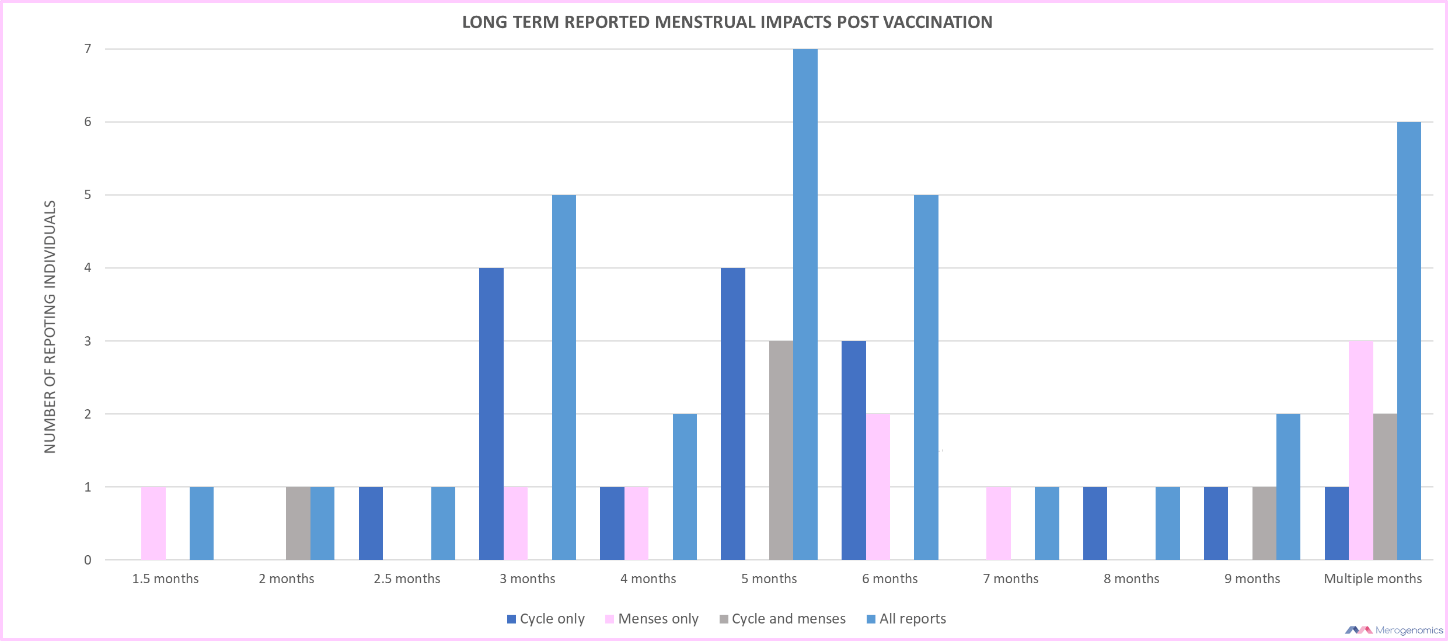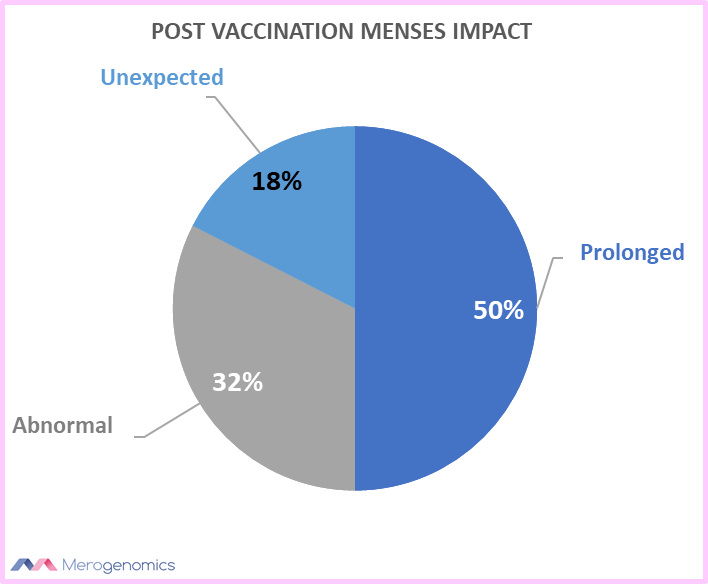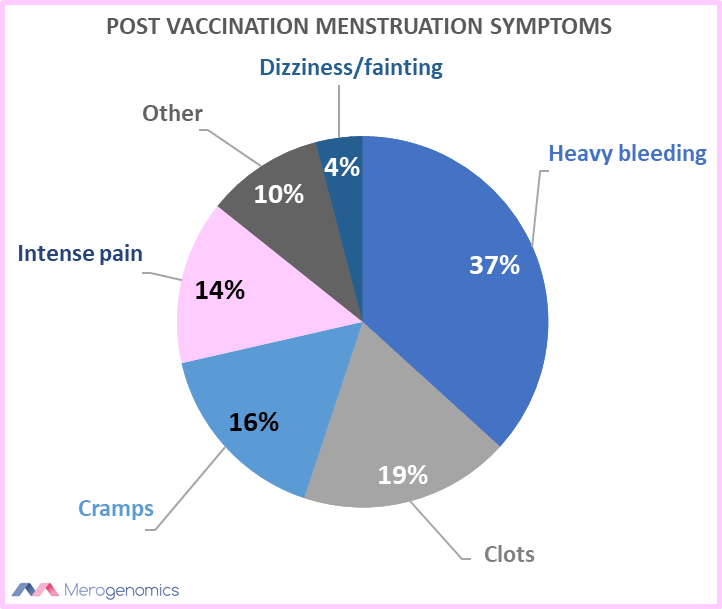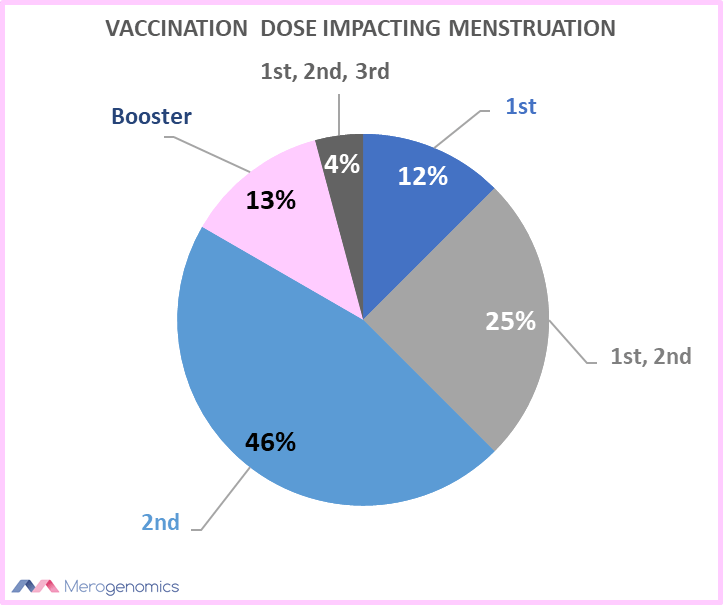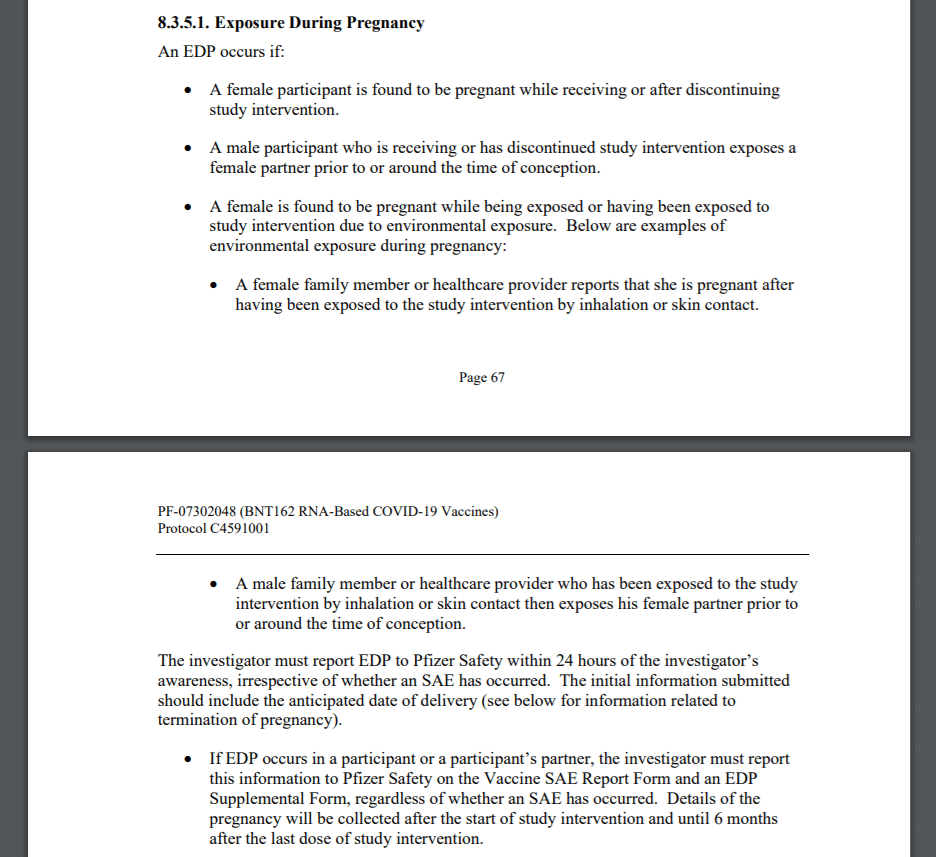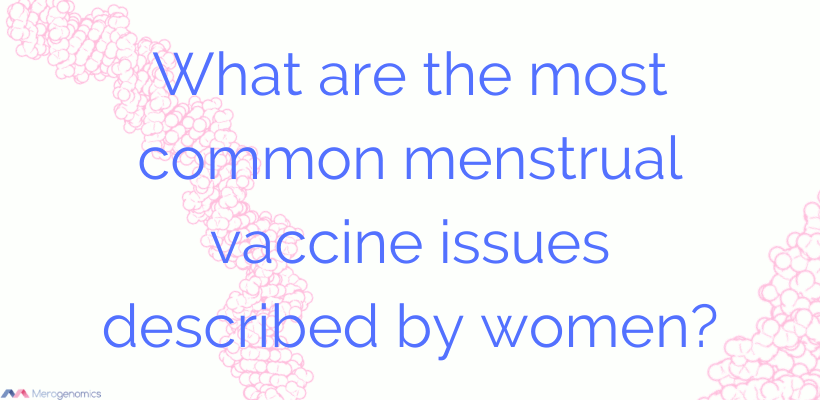
Post vaccination menstrual cycle analysis
Dr.M.Raszek
Dr.M.Raszek
Voice of concerned women
Recently Merogenomics has published a video (see below) on a scientific investigation into whether vaccines might be influencing the menstrual cycle and/or the duration of menses. According to the cited literature, the menstrual cycle post vaccination was delayed by nearly a day, with no impact on the duration of the period.
What followed the video was hundreds of comments that oscillated between gratitude for addressing a topic that previously no one really wanted to address, and fury over what seemed like a widely inaccurate conclusion in comparison to what so many women have experienced, and who described their extreme experiences in detail.
The question on so many of these women’s minds was, if my experience was so extreme (and we are about to get to that), how can the study come to such a seemingly innocuous conclusion as a cycle delay by a mere day. Dr. Raszek probably did not help by mentioning that the study’s conclusion of such a delay is totally within the norm.
But the comments we have received from women recounting their horrific experiences were nothing but mild, or innocuous, or within the norm.
We realized that many women might not have a proper outlet to be heard and so we decided to do a small, informal analysis of the Video’s comments presented to us, to track and make visible our viewers’ extreme versions of their real-life menstrual cycle impacts post vaccination. In other words, we used the Merogenomics YouTube video comments as open source data to help give voice to the extreme impacts on menstruation after a vaccination. We let women and their family and friends tell their stories which we decided to present in a graphical format that hopefully starts an interesting dialog at least until we see a proper scientific analysis of these extreme outcomes being reported!
The people who presented the information could be divided into three categories. The obvious one was those directly impacted post vaccination. Then, another was women whose menstrual cycle and/or period was impacted post COVID-19. But the last group was the biggest surprise, and a group we especially also wanted to respond to: those who were affected due to mere exposure to other vaccinated individuals.
Before we dive in, let’s describe some of the assumptions and liberties we are taking with this informal but important data. By “regular” we mean the menstruation cycle and not the period length unless clearly specified. The loss of periods was attributed to a cycle impact, and not period impact in our graphs. A period impact refers to some alteration to menses from what is expected to be the norm for that person.
Finally, please understand this is not a proper scientific analysis, only an observational study where we took liberties in how we present the information, and this is clearly not representative of the general population as the comments were self-selected to express extreme differences from reported science. We are only trying to take a look at what these reported extremes look like.
Menstrual cycle impact due to vaccination
In this category, we captured 67 individuals providing information describing approximately 81 different incidents. All but 8 of these were with regards to women who were menstruating and had either their cycle or period affected. The remaining 8 described non-menstruating women.
Of these, 31 reported on effects observed directly on themselves. All others reported on behalf of others, including 11 instances of reporting on family members.
Of the 8 non-menstruating reports, 7 were regarding menopausal women. All of these women started bleeding suddenly post vaccination. One of them was experiencing her first period in nearly 50 years, another in 35! The final self reported case was of a woman who was on a pill and started menstruating again after a year of no longer having a period.
In all of these descriptions, the impacts were reported as follows.
The described impacts were varied and exhibited a wide range of opposing effects of very broad duration, lasting mere days to many months. Focusing on the duration of effects, these are probably the most extreme and contrasting effects that have been reported. Any reports of effects lasting a month or more were marked as long-term impacts. These ranged from one month to the longest duration of 9 months post vaccination (and ongoing for many at the time of reporting). One unusual instance was recorded as permanent impact as the individual required removal of her ovaries and tubes. (Disclaimer: Please keep in mind that such an extreme medical procedure, reported on behalf of an acquaintance, might not at all be tied to vaccine impact.)
As can be seen from the graph below, the most frequently reported long term impacts were of 5 months in length. Long term impact on the menstrual cycle was reported more frequently than the impact on the period.
For those who commented on how the menstrual cycle was affected, complete loss of menstruation was the most commonly reported impact, while shortened or delayed cycles were commented on with same frequency. Others did not specify the impact, simply describing the cycle as becoming irregular.
Of all of the comments related to the affected cycle, only one woman added that her experience could be due to onset of the menopause as opposed to vaccines. For all other women who proclaimed their cycles have stopped, this was an unexpected event.
When it came to menses, its duration and accompanying symptoms or unexpected start that was outside the expected cycle were the main reported issues.
In the graph above, the women who started menstruating post menopause are also counted in the unexpected menses category, along with those who reported on unexpected spotting or period outside their regular cycle. Abnormal was considered any other information that affected the menses that did not report on prolonged or unexpected menses.
What was unexpected is the extreme lengths of continuous bleeding that people have reported. When menses duration was provided, bleeding lasting a month or more was most frequently observed. The most extreme reported case claimed continuous bleeding for 180 days! How ss that even possible? One instance recounted the need to go on iron treatments due to excessive blood loss.
For the unexpected menses, when bleeding occurred outside the norm (including in post-menstrual women), the average reported duration was 4.5 days.
Menses related symptoms were the most common symptoms captured from all symptoms described, namely, heavier flow, intensified cramps often with accompanying pain, and presence of clots.
Other symptoms included headache, nausea, heart problems, bigger breasts, and menopausal symptoms including night sweats.
The onset of impact was most frequently observed after the second vaccine injection but also seen post every injection received.
Menstrual cycle impact due to COVID-19
It was interesting to see that women also commented on their menstrual cycle being affected post SARS-CoV-2 infection. This could provide some evidence to the idea that observed impacts are caused by a mechanism that is mimicked between the virus and the vaccine. 11 of you provided information, all on behalf of own experience, and the long-term effects affecting the menstrual cycle was substantially longer than what has been observed with vaccination, possibly on account of the simple fact that the pandemic has preceded the availability of vaccines by a year, although it could also be because the natural infection could be more impactful.
7 women stated long term impacts, ranging from 2 to 21 months, with an average of 19 months. Impacts and side effects were similar to what was observed with vaccinations.
Suspected causes impacting menstruation post vaccination
As per the NIH that has funded research into the impact of vaccination on the menstruation, a menstrual cycle can be impacted by hormonal imbalances, gynecological diseases, or infections. The article that was commented on in the video stated that what is affected is the hypothalamus-pituitary-ovarian hormonal axis and the proof offered was the observation that women who received two vaccine injections in a single menstrual cycle, were more likely to observe a more severe impact on the delay of their menstrual cycle. But, however vaccinated women might have this hormonal axis affected, how unvaccinated women might be affected was not addressed. The fact that unvaccinated women in the same time period did not show the same or similar menstrual cycle delay suggested that observed effects are not merely due to stress, as in such a situation, similar impacts would be expected to be observed across the population irrespective of vaccination status.
Numerous suggestions were proposed by the commentators as to what might be causing these effects. Most frequently, and unsurprisingly, the primary suspect was the spike protein itself. This was further extended by others proposing that the endocrine system was being impacted, and most specifically, that it is the Follicle-Stimulating Hormone (FSH) of the pituitary gland that is affected, with its increased amount being responsible for shutting down the ovaries. FSH is responsible for growing follicles that hold the eggs and start ovulation.
Menstrual cycle impact due to exposure of vaccinated person
The most interesting and surprising commentary that was offered was women whose menstrual cycle was affected by mere exposure to others who were vaccinated. In total, 19 of you provided such information, 6 on behalf of others, half of which was on behalf of family members. Impacts were similar to those observed post vaccination, with delayed cycles, unexpected cycles, and stopped cycles. Once again, similar symptoms were also reported as previously. For 33% of those who provided information with regards to the expected vaccinated person causing the impact, it was an intimate partner, 27% of the time it was suspected to be a parent, and the remainder of 40% it was other non-family members.
When we heard of this, Merogenomics' first reaction was, “What? How is that even possible?” but we wanted to immediately offer some options to ensure we take the information seriously. At this time, before further research, the only statement we can offer is that humans do indeed leave a chemical/biological cloud that is specific to them, and maybe somehow such a cloud’s composition is being affected post vaccination and this imparts a direct influence on women. But what could be the contributing factor that could be correlated to the vaccination in such circumstances? What could be extruded from a body of a vaccinated person that could possibly be imparting such dramatic effect to affect a bystanders’ menstrual cycle?
Total mystery.
Interestingly, the best reason why we should no longer actually ignore this is found in the Pfizer vaccine clinical trials description document, which is the clinical trial that established the original, famous 95% vaccine efficacy data and which has lead to the vaccine approval by FDA, yet it stated the need for monitoring of just such a possibility! Can you believe monitoring for this very possibility was actually part of the original Pfizer clinical trial!
And the only difference, this was specifically to be monitored for a potential impact on pregnancy, not the menstrual cycle of women. It is the Pfizer clinical trial protocol that defines this type of exposure to vaccine. We show these definitions below where the Pfizer COVID-19 mRNA vaccine is defined as “study intervention”.
In that description, vaccine exposure during pregnancy is counted if male clinical trial participants expose a female partner prior to her becoming pregnant! How?
Why is this strange definition of exposure even there? How can vaccinated males expose a pregnant woman to their vaccine?
The exposure gets further defined for a pregnant woman who was “exposed to study intervention by inhalation or skin contact”. This would suggest that a pregnant woman would be considered exposed to the vaccine by breathing it in or through touching someone. Even weirder, a male who is exposed to the vaccine through inhalation or touch can then pose a risk of exposing the pregnant woman to further exposure.
How can that be explained? Either the authors of the study had foreknowledge of this possibility and only in the case of pregnant women did they decide to investigate the risk to the woman and the developing fetus, or they were over-abundantly cautious and investigating a possibility that was expected to be impossible but demonstrated it anyway for the importance of safety that is sought for pregnant women.
What could possibly explain that?
We offer only one explanation to consider for which there is no direct proof but an interesting accumulation of supporting observations that we present here.
This transfer of vaccination impact from vaccinated people to women could be through the exposure of exosomes or any other related small fragments of cells that have budded off and have been released to the environment.
We have already introduced the concept before that exosomes might allow the presence of spike proteins for a very long duration of time past vaccination.
But can they be transferred from human to human? Currently, there does not appear evidence of that, or if there is it would be very scant. In theory, such transfer could be feasible because airborne administration of exosome as an actual therapeutic treatment for COVID-19 has been proposed, and is currently investigated in clinical trials. It does not have to be too far of a stretch that close intimate contact could expose one person to exosomes from another person either through bodily fluids or even airborne particles of a solution containing it. Such mode of transmission of exosomes already has its own name, referred to as exosome horizontal transfer, and recently for the first time ever, exosomes were demonstrated to be used in virus transfer from one species to another, from insect salivary glands to a plant.
We already alluded to the possibility that exposure to spike protein directly could occur then if vaccinated individuals produce exosomes that carry the spike protein directly, but apparently, mRNA can also be transferred horizontally via exosomes, in this case, demonstrated from mouse cells to blood precursor cells.
Clearly, biology can be very complicated, and we are only just discovering these concepts.
If this were to be the case, we would be talking about a form of infection of either the spike protein directly or a spike protein development template in the form of the mRNA vaccine itself.
Perhaps women through their dysregulated menstrual cycle might have accidentally demonstrated a new phenomenon taking place between humans, which is the transfer of molecular information between individuals through exosomes. This clearly would require verification with many studies, including even determining if such horizontal transfer is possible of any kind to lead to described effects, and whether this is not explained by coincidental factors.
But at least we extended a possibility that could be investigated further. The study did not appear to have found anything in relation to such exposure based on FDA available data but it would have been interesting to see what would have been discovered if the same exposure to “study intervention” was applied in the context of menstruation. Impact on menstruation does not appear to have been a subject of any analysis or investigation.
To conclude, the comments offered to Merogenomics on its YouTube channel depart heavily from the conclusion of the first scientific study we could find on the topic and we desired to reward those who offered these comments with a visual presentation of the extreme impacts reported. We clearly require further studies into this topic, not only with regard to a frequency just to discover that the extreme impacts are rare, but to truly document what these impacts are, and what they might mean for the well-being of affected women.
We will conclude with our favourite comment:
“Sometimes us ladies are told that this sorta this is normal or it's just in our heads. Well, now we know it really is in our heads!” (in reference to the hypothalamus-pituitary-ovarian axis).
We invite you all to continue sharing your stories about how the menstrual cycle might have been affected either by vaccination, COVID-19, or the most unusual effect, exposure to other vaccinated individuals. If you chose to provide us with information, you can use the information we have visually presented here as a guide of what kind of content we were cataloguing.
We wish all of you a speedy recovery to healthy and normal cycles!
This article has been produced by Merogenomics Inc. and edited by Jason Chouinard, B.Sc. Reproduction and reuse of any portion of this content requires Merogenomics Inc. permission and source acknowledgment. It is your responsibility to obtain additional permissions from the third party owners that might be cited by Merogenomics Inc. Merogenomics Inc. disclaims any responsibility for any use you make of content owned by third parties without their permission.
Products and Services Promoted by Merogenomics Inc.
Select target group for DNA testing
Healthy screening |
Undiagnosed diseases |
Cancer |
Prenatal |
Or select popular DNA test
 |
 |
 |
 |
Pharmaco-genetic gene panel |
Non-invasive prenatal screening |
Cancer predisposition gene panel |
Full genome |



